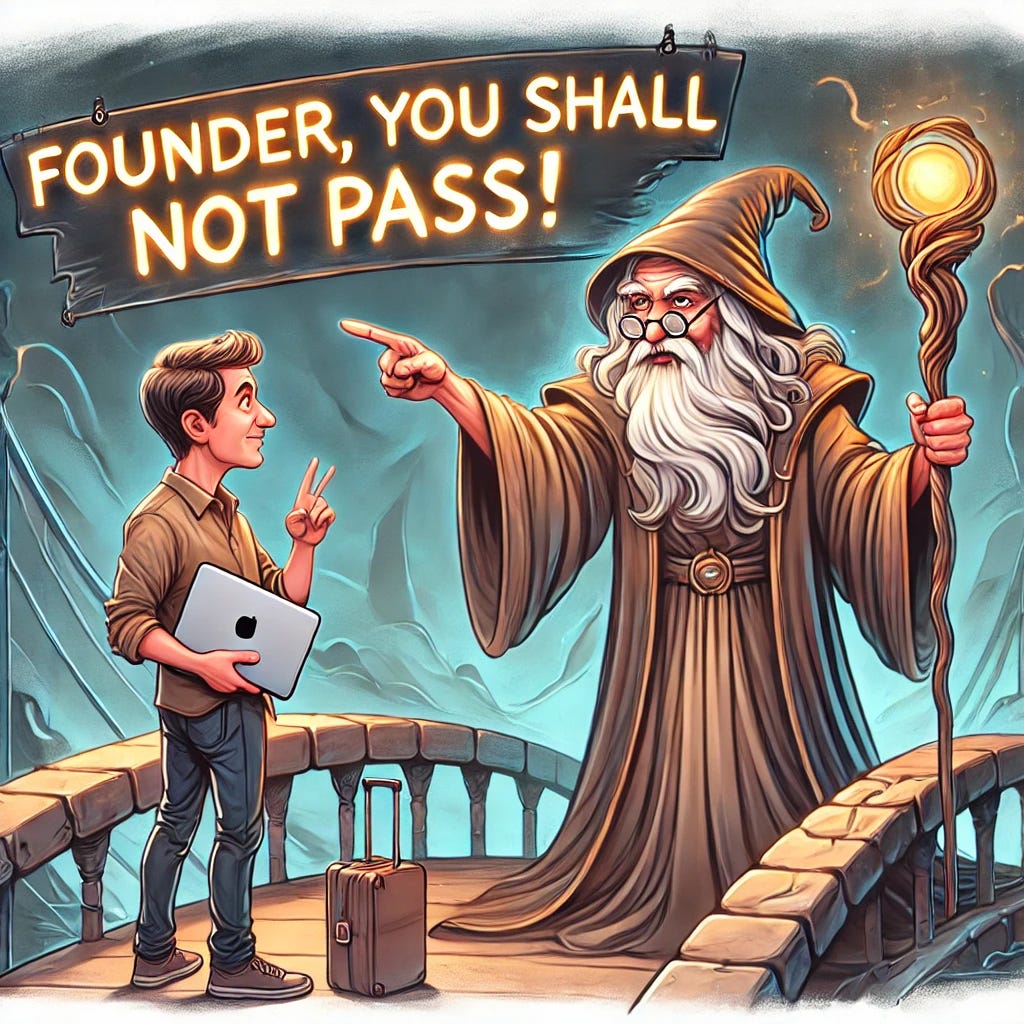“Hey founder – go find a problem, validate it with customers, solve it in a novel (or clever/disruptive/special) way, then move fast, fast, fast to get as many customers as you can. Raise all the money in the world to scale, and one day, exit for an insane valuation. From there, you join the race to Mars!!”
Sound and/or feel familiar? You’ve probably heard this advice – or some version of it – from startup ecosystems everywhere. And for good reason as there is plenty of truth in it, and Reid Hoffmans take on “Blitzscaling” is pretty fun to think about.
It’s a good playbook for the venture, but what about you, the founder?
Here’s a thing: venture capitalists in the early stage (post-product) are seeing an average of 40% of their capital deployed just to figure out the best go-to-market (GTM) strategy. That includes finding the right channels, sales approaches, digital marketing tactics, and customer acquisition strategies. It’s crucial work, but here’s the catch: that 40% isn’t their money – it’s essentially funded by your equity.
You may have experienced or read on how hard it is to raise VC money, particularly in Australia? It becomes a whole lot easier if you’ve already demonstrated your distribution strategy. Not only does it boost your valuation, but if you’re making money early, it reduces your need for desperate fundraising altogether. So here’s some founder math: why not figure this out first? why not figure this out (or have a well validated hypotheses on this) before you build anything? Even if you can’t answer every question, a highly validated hypotheses will give you the confidence to commit to the idea, find early revenue, and make that founder struggle just a little bit easier.
I know… boom.

Now, on the usual responses I have experienced in my years as a “advisor”, “coach” and/or “mentor” – lets address them:
Why will anyone talk to me when I have nothing to offer?
People like to help – as long as you’re adding value. Right now, you’re just someone seeking advice, which is way easier than selling them something later. Once you have a product, you’re no longer the innocent founder; you’re the greasy salesperson. Trust me, it’s easier to have those conversations now, and it is easier to then convert these conversations to revenue later.
What if they steal my idea?
Oh, founder. If you think someone will hear your pitch, drop everything, copy your idea, and dedicate their life to commercialisng it, you’ve been drinking a little too much startup Kool-Aid. Ideas are cheap; execution is everything. And if your idea is mind-blowing, people are more likely to help you – through mentorship, investment, or connections – than steal it. Besides, you can’t sell a secret. Most of this journey is about selling your story, so let it sing! There are exceedingly few situations where talking loudly about your idea or startup isn’t a net positive against the risk.
How do I begin?
This is the right question – and one you should ask before spending time and money building something no one may want.
I can’t stress to you how often a founder will build something, then go find a customer, only to realise what they built was not what the customer wanted, but something adjacent is, and they’ve had to go back and do it again.
IT ALL STARTS WITH THE USER
Ask yourself: who will use your creation? Are they the ones who will buy it, or does someone else make the purchase decision? This distinction – between user and customer – is critical. In a B2C context, they’re usually the same person. In B2B or enterprise settings, they’re often miles apart.
Let’s go down the rabbit hole of a B2C and B2B example:
B2C: Personal Finance App
Lets say we have developed this really clever way of managing someone’s personal finance/investment options and it is really great way for someone to track their decisions and comparatives, and you have used it yourself as has friends and family and it has been great, and they’d be happy to pay for it and all that. You’ve followed the “Traditional” approach of solving a problem, validating the problem and willingness to pay, and build something neat.
This is great – but… how… are you planning to access the customer en masse? There are some fun words like “viral marketing”, “digital marketing”, “word of mouth” and they loosely translate to “SPEND MONEY!” or “GET LUCKY!” and typically, both are scarce in early days.

But lets do that quick persona- the type of person that is looking at tools to manage their finance using are probably more educated, probably middle of their careers – perhaps starting to look at their first investment property or share options and are probably past that first home situation. Now – lets think about them in this phase “thinking” about how to invest/spend/manage their next move – are they googling – you’d hope so! are they going to see a financial advisor – probably the more wise ones. Where do you think they are pretty serious about things? At the google stage? Possibly not, but at the financial advisor stage – definitely. Given a typical financial advisor has access to 50-200 clients, we can create a really good hypotheses that if we could get financial advisors to recommend our app to their Customers, we would get distribution. Since financial advisors advertise their services, they are far easier to contact then each individual user.
But if the financial advisor is to be this channel, then we must know what is in it for for them? Do we need a product to explore this? No!… We just need to have a conversation and maybe a coffee. What are the problem that our idea may solve for the financial advisor… Well, lets ask them – typically a financial advisor key benefit is that based on their advice, their customers wealth grows over time, and said growth is higher then what the person would do without them, but also ideally higher then what others would do. Proving that the growth that occurred is better then what you would get down the street from Jim Bobs advice is hard… Or, perhaps they find it hard getting their customer to stay true or follow the plan and this impacts their results. Maybe you ask them – “If I had a comparison with industry built in so it can be compared, and maybe some features that help the user stay true to their goal – would you recommend the app to their customers? Would you buy the app as part of the service to the customer? Imagine if they said yes?!?! Imagine you had a conversation around what you think the customer will pay (or them) and it helped you guide that dreaded “what do I charge” question?
You now have an initial customer! and likely one that has access to 50 – 200 initial users. The initial customer would likely be excited to give feedback during the app build process on flows and designs, and ultimately, they would get those customers on that journey with you, and you are leveraging the credibility of the financial advisor has because you certainly don’t this early, and it is likely going to yield to quicker uptake of your product in these early stages, and likely quicker pathway to revenue.
Early revenue and customer adoption attracts investors, attracts talent and well, enables you alot more options and freedom.
B2B Example: IoT Sensors for Mines
Lets move up the “food chain” to large enterprise… Let’s say you’ve developed an IoT sensor that tracks key asset performance in mining. Your instinct once built is to call the site supervisor at Rio Tinto. They’ll love it, right?
Unfortunately for you, there is a couple of startup hating words built in to large enterprise, I’ll name my “favourites” – RISK, GOVERNANCE, PROCUREMENT, SECURITY.

The supervisor may love your thing, and may even take a free one to test to confirm, and it may operate amazingly well, but I would still not bet the house your winning the opportunity. You likely would not even pass the “trading history” requirements for many of these organisations to be taken seriously. You will get there – but this pathway….. I get flashbacks and go fetal remembering this pathway.
Maybe it has to be done – but before we get tunnel vision, let’s spend some time thinking about this. The large enterprise buys millions of dollars of tech from someone? They get that kit serviced and supported by someone? Their strategy is likely supported by consultants and other service providers surely? Yes, Yes and Yes…. See, these providers are fighting for relevance to the large enterprise, and bringing new and innovating things to them helps them to do precisely that. They have solved the startup hating words already and in some cases, can transact your product without any procurement process at all. And if their serving this large enterprise, they are likely supporting many more. We may have found a distribution angle.
Yes, they will also put you through the paces and will have their startup hating set of rules, but their more motivated usually as they are dealing with competitive pressures, and their focus is more on the product working, tested and you continuing to exist, and well, that is your world founder, and if you get that trust, they can walk you in to this customer, have you present your wares, and potentially circumnavigate many of the processes including my favorite – waiting to get paid. Ofcourse they will need a commercial construct that makes them money also and your margins need to allow this, but this can be a much quicker route…. Is this easy? No…. Should you explore it, yes…. because if it works once, you now have that juicy referencability that can get you very far. You do not need a product to talk to these organisations, and if they are excited by what you hope to do, they can be partners, beta testers, and yes, even investors if the timing and opportunity is right.
So.. distribution, distribution, distribution….
I’ve come to completely believe that distribution is the most important thing in the early stages of a startup. Building product (especially software) is getting faster and cheaper, so the real challenge is getting it into the hands of users at scale. That’s your moat. Nail your distribution strategy early, and you’ll be miles ahead of competitors, even if they have better products or are bigger beasts.
We spend too much time obsessing over ideas and not nearly enough on how to get them to market. Remember: the road to success is littered with the skeletons of great ideas that couldn’t find their users.
When I chat to my early stage founder friends, guess what I want to spend most of the time exploring and chatting about?
